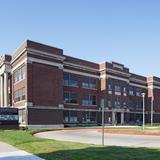School Highlights
Universal College of Healing Arts serves 46 students (98% of students are full-time).
The college's student-teacher ratio of 5:1 is lower than the state community college average of 16:1.
Minority enrollment is 67% of the student body (majority Black and Hispanic), which is more than the state average of 37%.
Quick Facts (2025-26)
- Enrollment: 46 students
- Private-state tuition: $15,390
- Acceptance Rate: 81%
- Student-teacher ratio: 5:1
- Minority enrollment: 67%
- Source: Integrated Postsecondary Education Data System (IPEDS)
Top Rankings
Universal College of Healing Arts ranks among the top 20% of public schools in Nebraska for:
Category
Attribute
Diversity
School Overview
The teacher population of 9 teachers has stayed relatively flat over five years.
Universal College of Healing Arts
(NE) Community College Avg.
Carnegie Classification
Special Focus Two-Year: Health Professions
Not applicable, not in Carnegie universe (not accredited or nondegree-granting)
Institution Level
At least 2 but less than 4 years
At least 2 but less than 4 years
Institution Control
Private for-profit
Private not-for-profit
Total Faculty
9 staff
233 staff
Student Body
The student population of Universal College of Healing Arts has grown by 76% over five years.
The student-teacher ratio of 5:1 has increased from 3:1 over five years.
The Universal College of Healing Arts diversity score of 0.68 is more than the state average of 0.57. The school's diversity has stayed relatively flat over five years.
Total Enrollment
46 students
1,449 students
Student-Teacher Ratio
5:1
16:1
# Full-Time Students
45 students
127 students
# Part-Time Students
1 students
1,322 students
# Enrollment Undergraduate
46 students
26 students
# Full-Time Undergraduate Students
45 students
114 students
# Full-Time Graduate Students
n/a
14 students
# Part-Time Undergraduate Students
1 students
1,322 students
Total Dormitory Capacity
n/a
357 students
% American Indian/Alaskan
n/a
1%
% Asian
1%
3%
% Hispanic
5%
16%
% Black
5%
6%
% White
33%
63%
% Hawaiian
43%
2%
% Two or more races
1%
3%
% Non Resident races
10%
1%
% Unknown races
2%
5%
Diversity Score
0.68
0.57
College Completion Rate (Students who graduate in less than 4 years)
1%
45%
Tuition and Acceptance Rate
The private state tuition of $15,390 is less than the state average of $16,095. The private state tuition has grown by 35% over four years.
Private State Tuition Fees
$15,390
$16,095
% Students Receiving Some Financial Aid
67%
81%
Median Debt for Graduates
$15,625
$11,000
Median Debt for Dropouts
n/a
$5,161
Acceptance Rate
81%
69%
Source: 2024 (or latest year available) Integrated Postsecondary Education Data System (IPEDS)
Frequently Asked Questions
How much does Universal College of Healing Arts cost?
Universal College of Healing Arts's private state tuition is approximately $15,390.
What is the acceptance rate of Universal College of Healing Arts?
The acceptance rate of Universal College of Healing Arts is 81%, which is higher than the state average of 69%.
What is Universal College of Healing Arts's ranking?
Universal College of Healing Arts ranks among the top 20% of community college in Nebraska for: Diversity in US community colleges.
In what neighborhood is Universal College of Healing Arts located?
Universal College of Healing Arts is located in the North Omaha neighborhood of Omaha, NE. There are 1 other community '.college.' located in North Omaha.
Recent Articles

The Rise of Technical and Vocational Training in 2025
Explore the 2025 surge in technical and vocational training—enrollment, policy, costs, and why this path is gaining ground for students and parents.

Stackable Credentials: How Community Colleges Advance Careers
Discover how community colleges use stackable credentials to build career pathways, boost earnings, and enable lifelong learning in 2025.

High-Paying Jobs You Can Get with a Community College Degree
Discover top high-paying careers you can launch in 2025 with a community college (associate) degree and high-growth credentials in tech, healthcare and trades.









